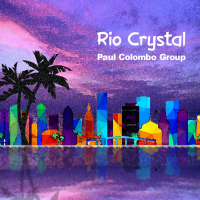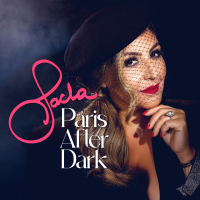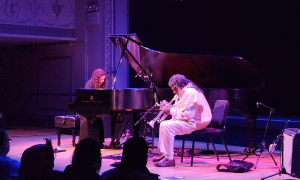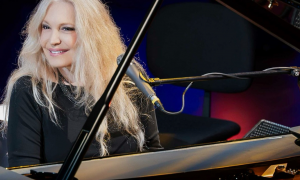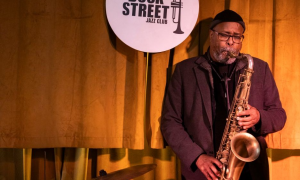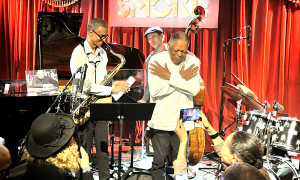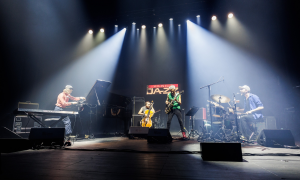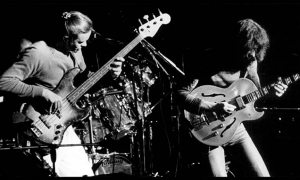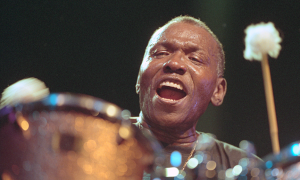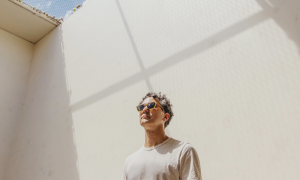Home » Jazz Articles » Live Review » Steve Sandberg Trio at Soapbox Gallery
Steve Sandberg Trio at Soapbox Gallery

Courtesy Betsyann Faiella
Soapbox Gallery
Brooklyn, NY
January 30, 2021
Pianist/composer Steve Sandberg presented a concert of his World Classical Music Project from Brooklyn's Soapbox Gallery, along with bassist Michael O'Brien and drummer Rudy Royston. It's a fascinating concept: Sandberg combines his love of the classical piano repertoire with new compositions inspired by those pieces, along with influences from other cultures around the world and jazz improvisation. Sometimes the new compositions relate directly to their classical inspiration, while at other times they manifest as a more abstract impression.
The show opened with Sandberg's solo performance of the Prelude from Maurice Ravel's Tombeau de Couperin, followed by the gentle modal jazz of his own "Maurice." It featured the first of many lyrical double bass solos from O'Brien, who proved himself equally adept as solo voice and accompanist. There was a small crew on hand to applaud the performance. Sandberg had a way of speaking to the camera (without using a microphone) that felt intimate: it really was like a concert in your living room. He spoke about Sophia Rosoff, his piano teacher, and her injunction to "only play what you love." And introduced his talented band members.
Next up was a J.S. Bach Three Part Invention in F minor, followed by Sandberg's Afro-Latin "Subindo." In addition to demonstrating Sandberg's pianistic skill in two very different styles, there was also another dynamic double bass solo. Sandberg explained that he learned to love Latin music by playing dance music, and he tries to always think about danceability. Chopin's mazurkas relate to this as Polish folk courtship dances. So the next piece was Chopin's Mazurka in C, followed by Sandberg's "Mazur," which included a lovely section with arco double bass.
Jean Sibelius' Valse Triste was an especially elaborate solo piano introduction, which appropriately had a very audible connection to Sandberg's "Trist Vals." The composition incorporated dramatic pauses, flawlessly executed by the trio. After the performance he confessed to incorporating a longtime ear worm into his solo, a phrase from a Robert Schumann piano piece (which he demonstrated). A Wolfgang Amadeus Mozart Gigue led into Sandberg's "Amadeus," which opened with a dynamic piano/drums duet. Nice to hear Royston stretch out a bit. "Monk's Mood" was simply introduced as something by "the great American composer Thelonious Monk." The only free-standing selection in the program, it was given a deliberate, rubato treatment—very much in keeping with the rest of the concert.
Commenting "there's a lot of Ravel tonight," Ravel's A La Manière de Borodin ("in the manner of Borodin," a tribute to the great Russian composer) introduced Sandberg's "Borodin." It employed a hypnotic Balkan dance rhythm, with arco bass doubling the second theme. Sandberg spoke of his appreciation of his teachers and his own teaching, noting that his students include a wide variety of ages and skill levels. The final segment began with Ravel's Alborada del Gracioso, followed by Sandberg's "Alborada Metamorph." Before beginning the Ravel piece he commented "now I'm going to have to actually play it." Which he did, after a false start, further humanizing the performance and emphasizing that it was really being streamed live. A lovely ending to a most enjoyable concert. Beautiful music in a beautiful setting, with a palpable feeling of human connection.
Tags
PREVIOUS / NEXT
Support All About Jazz
 All About Jazz has been a pillar of jazz since 1995, championing it as an art form and, more importantly, supporting the musicians who make it. Our enduring commitment has made "AAJ" one of the most culturally important websites of its kind, read by hundreds of thousands of fans, musicians and industry figures every month.
All About Jazz has been a pillar of jazz since 1995, championing it as an art form and, more importantly, supporting the musicians who make it. Our enduring commitment has made "AAJ" one of the most culturally important websites of its kind, read by hundreds of thousands of fans, musicians and industry figures every month.




